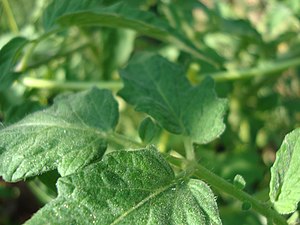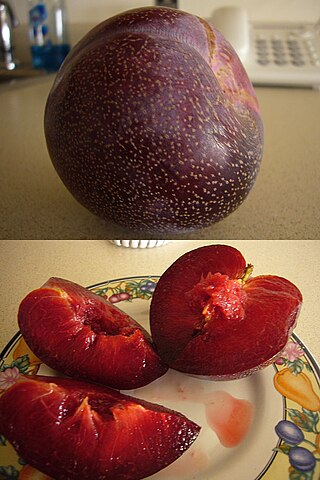
Pluots, apriums, apriplums, plumcots or pluclots are some of the hybrids between different Prunus species that are also called interspecific plums. Whereas plumcots and apriplums are first-generation hybrids between a plum parent and an apricot, pluots and apriums are later-generations. Both names "plumcot" and "apriplum" have been used for trees derived from a plum seed parent, and are therefore equivalent.

A mango is an edible stone fruit produced by the tropical tree Mangifera indica. It is believed to have originated in southern Asia, particularly in eastern India, Bangladesh, and the Andaman Islands. M. indica has been cultivated in South and Southeast Asia since ancient times resulting in two types of modern mango cultivars: the "Indian type" and the "Southeast Asian type". Other species in the genus Mangifera also produce edible fruits that are also called "mangoes", the majority of which are found in the Malesian ecoregion.

The bell pepper is the fruit of plants in the Grossum Group of the species Capsicum annuum. Cultivars of the plant produce fruits in different colors, including red, yellow, orange, green, white, chocolate, candy cane striped, and purple. Bell peppers are sometimes grouped with less pungent chili varieties as "sweet peppers". While they are botanically fruits—classified as berries—they are commonly used as a vegetable ingredient or side dish. Other varieties of the genus Capsicum are categorized as chili peppers when they are cultivated for their pungency, including some varieties of Capsicum annuum.
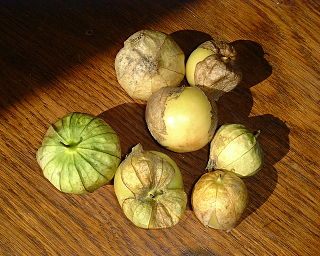
The tomatillo, also known as the Mexican husk tomato, is a plant of the nightshade family bearing small, spherical, and green or green-purple fruit of the same name. Tomatillos originated in Mexico and were cultivated in the pre-Columbian era. A staple of Mexican cuisine, they are eaten raw and cooked in a variety of dishes, particularly salsa verde. The tomatillo is a perennial plant but is generally grown for agriculture each year as if it were an annual.

Ziziphus mauritiana, also known as Indian jujube, Indian plum, Chinese date, Chinee apple, ber and dunks is a tropical fruit tree species belonging to the family Rhamnaceae. It is often confused with the closely related Chinese jujube, but whereas Z. jujuba prefers temperate climates, Z. mauritiana is tropical to subtropical.
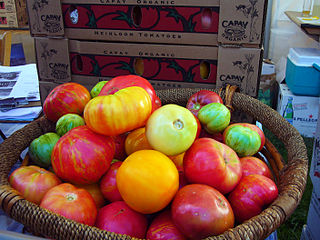
An heirloom tomato is an open-pollinated, non-hybrid heirloom cultivar of tomato. They are classified as family heirlooms, commercial heirlooms, mystery heirlooms, or created heirlooms. They usually have a shorter shelf life and are less disease resistant than hybrids. They are grown for various reasons: for food, historical interest, access to wider varieties, and by people who wish to save seeds from year to year, as well as for their taste.

A beef tomato or beefsteak tomato is a large tomato. Grown on the plant Solanum lycopersicum, it is one of the largest varieties of cultivated tomatoes, regularly at 20 cm (6 in) in diameter with some weighing 450 g (1 lb) or more. Most are pink or red with numerous small seed compartments (locules) distributed throughout the fruit, sometimes displaying pronounced ribbing similar to ancient pre-Columbian tomato cultivars. While popular among home growers for beef sandwich toppings and other applications requiring a large tomato such as toppings on large steaks, beefsteaks are not grown commercially as often as other types, since they are not considered as suitable for mechanization as smaller slicing tomatoes. Non-commercially, however, they are the most popularly grown tomato in North America.

Garden Peach tomatoes are a cultivar of tomato, native South American fruit mainly from Peru. Its small, bright yellow fruit is the standard globe shape of tomato. With its yellow coloring, blushing vaguely pink mottling when very ripe, and fuzzy skin, it resembles a peach. This cultivar is also extremely prolific. It is rich in iron and vitamin B5. The plant grows naturally between 200 and 1,000 metres from Colombia to Ecuador and Perú.

Green Zebra is a tomato cultivar with characteristic dark green and yellow stripes. Newer variations blush reddish instead of yellow when ripe. It is more tart than a regular tomato, and it is an early cultivar. Compared to other tomato varieties, it can produce somewhat mealy fruits depending on growing conditions.

The Brandywine tomato is an heirloom cultivar of tomato, with large potato-leaved foliage and large pink beefsteak-shaped fruit. It is popularly considered among the best tasting available.
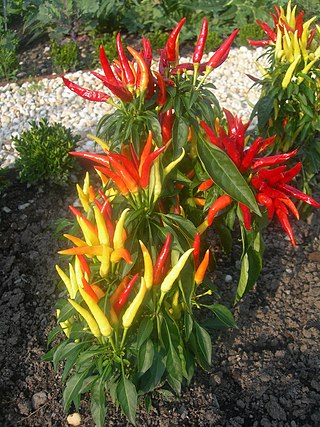
Medusa peppers are a type of sweet, ornamental chili pepper which grow upright, brightly colored fruit, and which are long and thin, producing a "hair of snakes" look suggestive of the gorgon Medusa in Greek mythology.

The tomato is the edible berry of the plant Solanum lycopersicum, commonly known as the tomato plant. The species originated in western South America, Mexico, and Central America. The Nahuatl word tomatl gave rise to the Spanish word tomate, from which the English word tomato derived. Its domestication and use as a cultivated food may have originated with the indigenous peoples of Mexico. The Aztecs used tomatoes in their cooking at the time of the Spanish conquest of the Aztec Empire, and after the Spanish encountered the tomato for the first time after their contact with the Aztecs, they brought the plant to Europe, in a widespread transfer of plants known as the Columbian exchange. From there, the tomato was introduced to other parts of the European-colonized world during the 16th century.
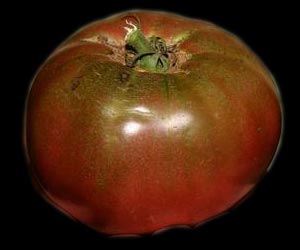
Cherokee Purple is the name of an old variety of tomato that develops a fruit with a deep, dusky-rose color while maintaining a somewhat greenish hue near the stem when mature for eating. The deep crimson interior and clear skin combination give it its distinctive color. It was one of the first of the darker color group of tomatoes sometimes described as "blacks." Southern Exposure Seed Exchange was the first seed company to offer Cherokee Purple, released in limited quantity in 1993. The Cherokee Purple has become a popular heirloom variety.

Tigerella is a bi-colored tomato cultivar, relatively small, 2 to 4 ounces, and early. Upon maturity the fruit is red with yellow stripes, essentially the same as Green Zebra, except that the fruit is red instead of green, and has a sweeter flavor. The colour occasionally varies, in New Zealand for instance, commercially produced Tigerella is dark crimson red with very dark green stripes.
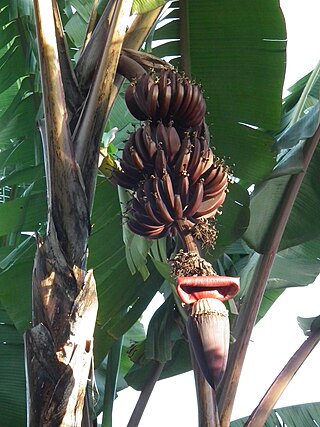
Red bananas are a group of varieties of banana with reddish-purple skin. Some are smaller and plumper than the common Cavendish banana, others much larger. When ripe, raw red bananas have a flesh that is cream to light pink in color. They are also softer and sweeter than the yellow Cavendish varieties, some with a slight raspberry flavor and others with an earthy one. Many red bananas are exported by producers in East Africa, Asia, South America and the United Arab Emirates. They are a favorite in Central America as a form of aphrodisiac juice, along with being a favourite in India in order to promote fertility but are sold throughout the world.
The Big Rainbow heirloom tomato is one of dozens of large fruited yellow tomatoes with red swirls. They have a mild, sweet flavor. The Hillbilly tomato is another similar-coloured tomato.
The Hillbilly Tomato, scientific name Solanum lycopersicum, is an heirloom cultivar originating from West Virginia in the 1800s. There is also a potato-leaf variant named Hillbilly Potato Leaf. The fruit is considered a beefsteak tomato weighing 1-2 pounds. It is round, heavily ribbed and its skin and flesh is orange-yellow with red streaks. The flavor is described "sweet and fruity" and is low in acid.
Lillian's Yellow tomato is a late season heirloom tomato collected by Lillian Bruce of Tennessee. She gave seeds to Robert Richardson, after which it found its way into the Seed Savers Exchange yearbook. One of the few bright yellow varieties, Lillian's Yellow Tomato is a potato leaved plant that requires a long growing season. The fruit is meaty, full flavored and contains few seeds.

Aunt Ruby's German Green heirloom tomatoes are a cultivar originating with Ruby Arnold, of Greeneville, Tennessee, but achieving great Seed Savers popularity. They are, as the name implies, "green" tomatoes, which really means they are a greenish yellow when fully ripe, but are still tasty when picked early.

The habanero is a hot variety of chili. Unripe habaneros are green, and they color as they mature. The most common color variants are orange and red, but the fruit may also be white, brown, yellow, green, or purple. Typically, a ripe habanero is 2–6 centimetres long. Habanero chilis are very hot, rated 100,000–350,000 on the Scoville scale. The habanero's heat, flavor, and floral aroma make it a popular ingredient in hot sauces and other spicy foods.
